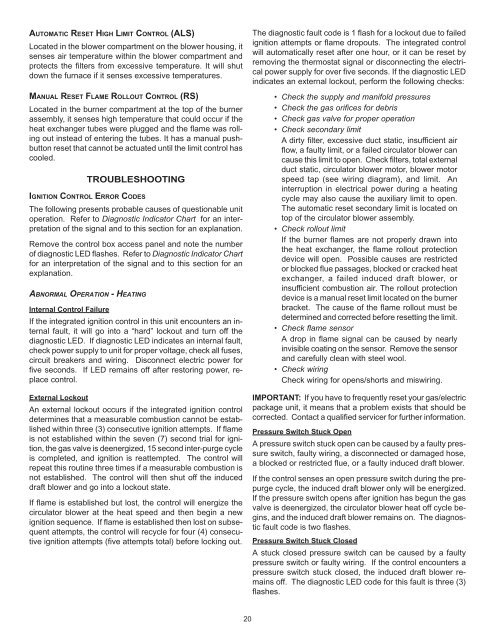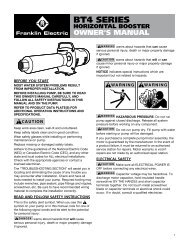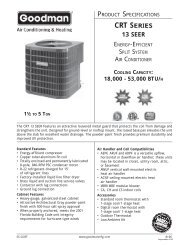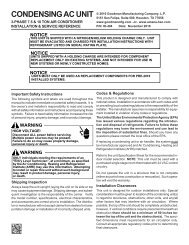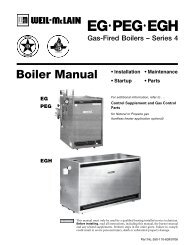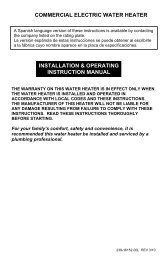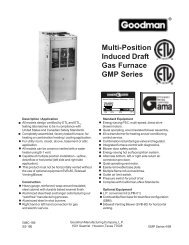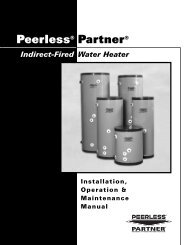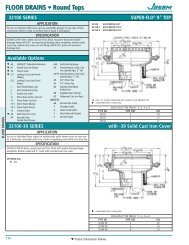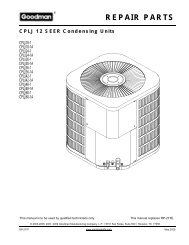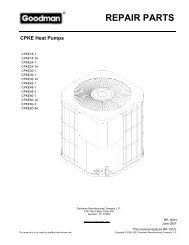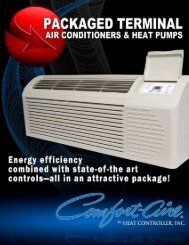7.5 TON - 12.5 TON PACKAGE GAS SERIES CPG SERIES - Goodman
7.5 TON - 12.5 TON PACKAGE GAS SERIES CPG SERIES - Goodman
7.5 TON - 12.5 TON PACKAGE GAS SERIES CPG SERIES - Goodman
Create successful ePaper yourself
Turn your PDF publications into a flip-book with our unique Google optimized e-Paper software.
AUTOMATIC RESET HIGH LIMIT CONTROL (ALS)<br />
Located in the blower compartment on the blower housing, it<br />
senses air temperature within the blower compartment and<br />
protects the filters from excessive temperature. It will shut<br />
down the furnace if it senses excessive temperatures.<br />
MANUAL RESET FLAME ROLLOUT CONTROL (RS)<br />
Located in the burner compartment at the top of the burner<br />
assembly, it senses high temperature that could occur if the<br />
heat exchanger tubes were plugged and the flame was rolling<br />
out instead of entering the tubes. It has a manual pushbutton<br />
reset that cannot be actuated until the limit control has<br />
cooled.<br />
TROUBLESHOOTING<br />
IGNITION CONTROL ERROR CODES<br />
The following presents probable causes of questionable unit<br />
operation. Refer to Diagnostic Indicator Chart for an interpretation<br />
of the signal and to this section for an explanation.<br />
Remove the control box access panel and note the number<br />
of diagnostic LED flashes. Refer to Diagnostic Indicator Chart<br />
for an interpretation of the signal and to this section for an<br />
explanation.<br />
ABNORMAL OPERATION - HEATING<br />
Internal Control Failure<br />
If the integrated ignition control in this unit encounters an internal<br />
fault, it will go into a “hard” lockout and turn off the<br />
diagnostic LED. If diagnostic LED indicates an internal fault,<br />
check power supply to unit for proper voltage, check all fuses,<br />
circuit breakers and wiring. Disconnect electric power for<br />
five seconds. If LED remains off after restoring power, replace<br />
control.<br />
External Lockout<br />
An external lockout occurs if the integrated ignition control<br />
determines that a measurable combustion cannot be established<br />
within three (3) consecutive ignition attempts. If flame<br />
is not established within the seven (7) second trial for ignition,<br />
the gas valve is deenergized, 15 second inter-purge cycle<br />
is completed, and ignition is reattempted. The control will<br />
repeat this routine three times if a measurable combustion is<br />
not established. The control will then shut off the induced<br />
draft blower and go into a lockout state.<br />
If flame is established but lost, the control will energize the<br />
circulator blower at the heat speed and then begin a new<br />
ignition sequence. If flame is established then lost on subsequent<br />
attempts, the control will recycle for four (4) consecutive<br />
ignition attempts (five attempts total) before locking out.<br />
The diagnostic fault code is 1 flash for a lockout due to failed<br />
ignition attempts or flame dropouts. The integrated control<br />
will automatically reset after one hour, or it can be reset by<br />
removing the thermostat signal or disconnecting the electrical<br />
power supply for over five seconds. If the diagnostic LED<br />
indicates an external lockout, perform the following checks:<br />
• Check the supply and manifold pressures<br />
• Check the gas orifices for debris<br />
• Check gas valve for proper operation<br />
• Check secondary limit<br />
A dirty filter, excessive duct static, insufficient air<br />
flow, a faulty limit, or a failed circulator blower can<br />
cause this limit to open. Check filters, total external<br />
duct static, circulator blower motor, blower motor<br />
speed tap (see wiring diagram), and limit. An<br />
interruption in electrical power during a heating<br />
cycle may also cause the auxiliary limit to open.<br />
The automatic reset secondary limit is located on<br />
top of the circulator blower assembly.<br />
• Check rollout limit<br />
If the burner flames are not properly drawn into<br />
the heat exchanger, the flame rollout protection<br />
device will open. Possible causes are restricted<br />
or blocked flue passages, blocked or cracked heat<br />
exchanger, a failed induced draft blower, or<br />
insufficient combustion air. The rollout protection<br />
device is a manual reset limit located on the burner<br />
bracket. The cause of the flame rollout must be<br />
determined and corrected before resetting the limit.<br />
• Check flame sensor<br />
A drop in flame signal can be caused by nearly<br />
invisible coating on the sensor. Remove the sensor<br />
and carefully clean with steel wool.<br />
• Check wiring<br />
Check wiring for opens/shorts and miswiring.<br />
IMPORTANT: If you have to frequently reset your gas/electric<br />
package unit, it means that a problem exists that should be<br />
corrected. Contact a qualified servicer for further information.<br />
Pressure Switch Stuck Open<br />
A pressure switch stuck open can be caused by a faulty pressure<br />
switch, faulty wiring, a disconnected or damaged hose,<br />
a blocked or restricted flue, or a faulty induced draft blower.<br />
If the control senses an open pressure switch during the prepurge<br />
cycle, the induced draft blower only will be energized.<br />
If the pressure switch opens after ignition has begun the gas<br />
valve is deenergized, the circulator blower heat off cycle begins,<br />
and the induced draft blower remains on. The diagnostic<br />
fault code is two flashes.<br />
Pressure Switch Stuck Closed<br />
A stuck closed pressure switch can be caused by a faulty<br />
pressure switch or faulty wiring. If the control encounters a<br />
pressure switch stuck closed, the induced draft blower remains<br />
off. The diagnostic LED code for this fault is three (3)<br />
flashes.<br />
20


